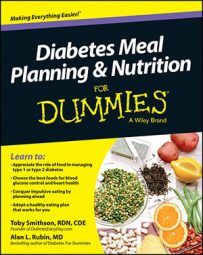If an occasion to eat at a restaurant comes up without time for preplanning, you can still make the healthier, diabetic-friendly choices. The biggest difference is that you’re making your choices surrounded by distractions and engulfed in an atmosphere created to trigger your eating instincts.
These are powerful influences, but you can make healthy choices if you concentrate on what you know about your diabetes meal plan — manage carbohydrates from all sources, look to reduce dietary fat, and reduce sodium.
You can access nutrition information from your table on mobile devices, either from websites or apps. Some apps even evaluate the menu items with a letter grade or rating system, but whereas these can be great for calories, fat, and sodium, the rating criteria generally doesn’t take carbohydrate content into account (but the detailed information provides a number for you).
Alternatively, you can request nutrition information from the restaurant — most are able to bring you the information at your table, or while you’re waiting.
So, now you can spend 30 minutes ignoring your friends while you evaluate every single item on the menu, right? Of course you can’t, and that’s part of the challenge when you haven’t been able to plan ahead. The menu descriptions can give some valuable clues about healthy and not-so-healthy choices, however, so you can narrow your options down to a few, check the details on those, make a choice, and join the conversation.
Here are some tips for analyzing menu items:
Look for clues in the cooking method. Healthier cooking styles include baked, grilled, steamed, poached, and broiled. Not-so-healthy methods are deep fried, flash fried, escalloped, or creamed.
Be careful with breaded or batter-dipped foods, crusts or double crusts, sweet and sour dishes, or syrups because of the added carbohydrates.
Be cautious about sauces and glazes — most are high in calories and fat, and some are sweetened.
Be aware of portion sizes for foods you know are carbohydrates — bread, pasta, rice, and potatoes are often served in liberal portions. One slice of bread, 3 ounces of baked potato, and 1/3 cup cooked rice or pasta are all 15 grams of carbohydrate.
Don’t assume that a meal-sized salad is healthy just because it’s a salad — read the ingredients, and take the dressing on the side (or go for an alternative nonfat dressing like lemon or lime juice, or plain balsamic vinegar).
Look at the appetizer menu. Often it’s possible to get similar foods in smaller portions.
There’s not much you can do differently when it comes to fast foods. Go for broiled or grilled rather than fried, avoid mayonnaise and special sauces when possible (you can scrape them off), watch the carbohydrates in bread, buns, French fries, and sweetened drinks, and go for thin-crust pizzas to minimize the carbohydrates from thick crusts.
Nonstarchy vegetables, like lettuce and tomato, can fill you up, and add almost no carbohydrates to your meal. Sandwich shops and pizza joints always offer a variety of nonstarchy vegetables.
One way to know whether you’ve made the best choices is to test your blood glucose levels two hours after you eat. Over time, patterns can inform your choices the next time you find yourself choosing from the same menu.

